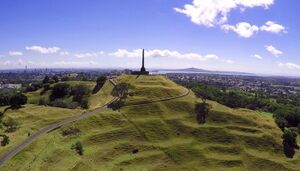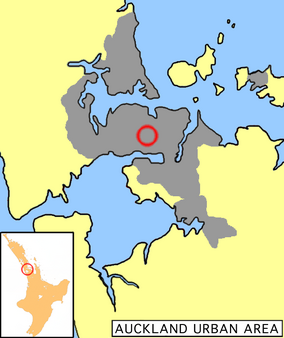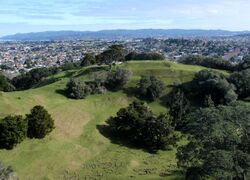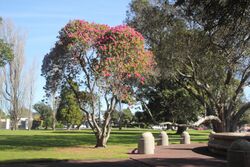One Tree Hill (New Zealand)
Topic: Earth
 From HandWiki - Reading time: 9 min
From HandWiki - Reading time: 9 min
| Maungakiekie | |
|---|---|
| One Tree Hill | |
 Maungakiekie / One Tree Hill after the removal of the "one tree". | |
| Highest point | |
| Elevation | 182 m (597 ft) |
| Coordinates | [ ⚑ ] : 36°54′0″S 174°46′59″E / 36.9°S 174.78306°E |
| Geography | |
| Location | North Island, New Zealand |
| Geology | |
| Volcanic arc/belt | Auckland volcanic field |
Maungakiekie / One Tree Hill is a 182-metre (597 ft) volcanic peak in Auckland, New Zealand. It is an important memorial place for both Māori and other New Zealanders. The suburb around the base of the hill is also called One Tree Hill. It is surrounded by the suburbs of Royal Oak to the west, and clockwise, Epsom, Greenlane, Oranga, and Onehunga. The summit provides views across the Auckland area, and allows visitors to see both of Auckland's harbours.
The hill's scoria cones were erupted from three craters – one is intact and two have been breached by lava flows that rafted away part of the side of the scoria cone. Lava flows went in all directions, many towards Onehunga, covering an area of 20 square kilometres (7.7 sq mi), making it the second largest (in area covered) of the Auckland volcanic field, behind Rangitoto Island. The volcano erupted approximately 60,000 years ago.[citation needed]
History
Māori pā (fort)
The Māori name Maungakiekie means "mountain of the kiekie vine".[1] Māori also knew it as "tōtara that stands alone".[2] The mountain and its surrounds were home to the Te Wai ō Hua tribe from the early 1700s and probably before that time. Other Māori tribes in the Auckland area can also trace their ancestry to the mountain.
Maungakiekie was the largest and most important Māori pā in pre-European times. The cone and its surroundings are estimated to have been home to a population of up to 5,000.[3] At this time, the Nga Marama chief Kiwi Tamaki held the pa and used its strategic placement to exact tribute from travellers passing from Northland to the rest of the North Island through the rich isthmus. Its position between the Waitematā Harbour to the east (opening upon the Pacific Ocean) and the Manukau Harbour to the west (opening onto the Tasman Sea) offered a wide variety of seafood from the two harbours. The volcanic soil on the scoria cone was highly fertile, and the inhabitants terraced the slopes extensively. The hill was relatively easy to defend from raiding parties from other tribes by its steep sides and imposing wooden palisades. Waiohua occupation of the Māori pā ended around 1740-1750 AD when they were defeated in a war against the invading Ngati Whatua-o-Kaipara[4] The pā was abandoned around 1795 AD with the death of Te Taou leader Tuperiri.[5]
In 1845 the Ngati Whatua, with the concurrence of representatives of the Waiohua people, sold a block of land which included Maungakiekie / One Tree Hill to a merchant, Thomas Henry. The Government under its preemptive rights excluded 115 acres of the hill itself from the sale and this was vested in the Crown. This is now One Tree Hill Domain.[6] In 1853 Brown & Campbell purchased Henry's land surrounding the recently protected One Tree Hill Domain. This land ultimately became Cornwall Park in 1901.[7]
In 1964 the government led an initiative to restore the mountain. After two years the initiative was cancelled and the mountain left alone.[citation needed]
One Tree Hill Domain
One Tree Hill Domain, a 118-acre (48 ha) park, is owned by Ngā Mana Whenua o Tāmaki Makaurau Collective and administered by Ngā Mana Whenua o Tāmaki Makaurau Authority. One Tree Hill Domain adjoins Cornwall Park's 425 acres (172 ha), creating a total of 540 acres (220 hectares) of public green space.[8]
The hilltop is always accessible by foot, but because it became a nightly party stop for boy racers and other (often drunk) groups of youths, after-dark road access to the summit was closed in 2008.[2]
The area contains two parks, One Tree Hill Domain and Cornwall Park, which are next to each other and thus often perceived as one. One Tree Hill Domain is open to the public and was formerly administered by Auckland City Council but since 2012 has been owned and administered by Ngā Mana Whenua o Tāmaki Makaurau Collective.[9] All decisions are made by the owners, who have delegated minor day-to-day operations to Cornwall Park Trust. Cornwall Park is a private park, also open to the public, administered by the Cornwall Park Trust Board. The Trust's endowment includes income from leasehold properties adjoining the park's borders.[10]
Because One Tree Hill Domain is high and relatively central, the city has long used it for its potable water reservoirs. The first of these was constructed in 1900 atop the western peak; though it is no longer in service, the small structure remains in place. Five further reservoirs were subsequently built underground, with the latest completed in 1977. They are currently used to maintain supply to the Onehunga area and to the reservoirs atop Maungawhau / Mount Eden.
Cornwall Park
Cornwall Park, which adjoins the domain, was given by Sir John Logan Campbell to a private trust he had established to hold the land for the use of the public.[11]
Treaty settlement
In the 2014 Treaty of Waitangi settlement with the Tamaki Makaurau Collective of 13 Auckland iwi, the volcano was officially named Maungakiekie / One Tree Hill and ownership was vested to the collective. It is now co-governed by the collective and Auckland Council in common benefit of the iwi "and all other people of Auckland".[12][13][14][15][16][17]
Features
Obelisk
On the summit of the hill is an obelisk, a memorial to Māori.[18] Before the obelisk stands a bronze statue of a Māori warrior. The stone obelisk was designed by Richard Atkinson Abbot and completed in 1940, but the unveiling of the obelisk was delayed until after World War II on 24 April 1948. This was in keeping with Māori custom of not holding such ceremonies during a time of bloodshed.
Beneath it is the grave of Sir John Logan Campbell who bequeathed £5,000 for the obelisk. His grave is a plain granite slab, ornamented only by a bronze wreath. It lies in the middle of the viewing platform, on axis with the main memorial plaques on the Obelisk base and the bronze Warrior Statue.[18]
Campbell, like many European New Zealanders of his generation, had expected that Māori would gradually die out and that an impressive memorial would be a most fitting symbol to perpetuate their memory.[19] By the 1930s this had obviously not happened, and some considered the term "memorial" was inappropriate with many Māori objecting to its use. During construction of the obelisk, a suggestion was made that it should be described as a centennial tower to mark the centennial year of the signing of the Treaty of Waitangi and not a memorial.[19]
Stardome Observatory
The Stardome Observatory (previously known as Auckland Observatory), is located within One Tree Hill Domain, and contains two telescopes and a planetarium. The observatory has, amongst other research, discovered and named the asteroid 19620 Auckland. Its current functions combine entertainment and education (via the planetarium and via public access to the older telescope) as well as ongoing research with both telescopes. It is operated by a charitable trust.
Summit trees
When Auckland was founded as a colonial town a tree stood near the summit which gave the hill its English name. Two accounts identify it as a pōhutukawa (Metrosideros excelsa). This tree was cut down by a pākehā settler in 1852, in an act of vandalism in one account,[20] or for firewood in another.[2] It seems likely this was a different tree from the tōtara (Podocarpus totara) which, as a sacred tree, had given the hill one of its Maori names. A radiata pine was planted in the 1870s to replace the previous tōtara .[21] John Logan Campbell repeatedly tried to grow native trees on the hill's summit, but the trees failed to survive - with only two pines, originally part of a shelter belt for the native trees, surviving for long. However, in 1960, one of the two was felled in another attack,[2] possibly for firewood.[citation needed]
The remaining tree was later attacked twice with chainsaws by Māori activists to draw attention to injustices the New Zealand government had inflicted upon Māori. The first attack happened on 28 October 1994, the anniversary of the 1835 Declaration of Independence.[22] A second attack on 5 October 2000[23] left the tree unable to recover even though substantial efforts were made, and so it was removed on 26 October due to the risk of it collapsing.[2] The chainsaw used in the first attack was later placed on sale on popular New Zealand auction site, TradeMe in 2007,[24] but later withdrawn by the website after complaints and a poll of users. It was later listed on eBay.[25] The chainsaw is now in the collection of Museum of New Zealand Te Papa Tongarewa.[26]
A well-attended dawn ceremony conducted by Tupuna Maunga Authority took place upon Maungakiekie on 11 June 2016 planting nine young tōtara and pōhutukawa grown from parent trees on the hill. A kiekie will be added later.[27]
In popular culture
- Irish rock band U2 wrote a song about the hill, "One Tree Hill", which appeared on their album The Joshua Tree. It was written to honour New Zealander Greg Carroll, an employee of the band who died in a motorcycle accident in Dublin on 3 July 1986.
- The naming of the teen television drama, One Tree Hill and the show's final episode, was inspired in turn by the U2 song.[28] In the series Andy Hargrove hails from New Zealand. His mother moved the family to Tree Hill, North Carolina because of the common name.
- Asteroid 23988 Maungakiekie was named after the hill by Ian P. Griffin, a British astronomer. The asteroid was discovered at the Auckland Observatory which is located in the One Tree Hill Domain, a kilometre southwest of the peak.
- Mozilla Firefox 0.9 was named One Tree Hill by Auckland resident and (at that time) Firefox lead engineer Ben Goodger.
References
- ↑ Cornwall Park website. Retrieved 8 November 2009
- ↑ 2.0 2.1 2.2 2.3 2.4 "Vandals force One Tree Hill to be locked". The New Zealand Herald. NZPA. 8 October 2008. http://www.nzherald.co.nz/auckland-region/news/article.cfm?l_id=117&objectid=10536509. Retrieved 1 November 2011.
- ↑ One Tree Hill Domain (Maungakiekie) (from the Auckland City Council website. Retrieved 2007-12-10.)
- ↑ http://www.teara.govt.nz/en/auckland-region/page-6
- ↑ [1] From Tamaki Makau-Rau to Auckland
- ↑ [2](One Tree Hill Domain Origin)
- ↑ (Brochure "Sir John Logan Campbell" - Cornwall Park Information Center )
- ↑ [all decisions are made by the owners Auckland Council] accessed 10 February 2016
- ↑ "Ngā Mana Whenua o Tāmaki Makaurau Collective Redress Act 2014" (in en-NZ). http://www.legislation.govt.nz/act/public/2014/0052/latest/DLM5322500.html.
- ↑ "Ground Leases and Conditions of Entry". http://www.cornwallpark.co.nz/index.php?s=6.
- ↑ "About Us". http://www.cornwallpark.co.nz/index.php?s=2.
- ↑ Dearnaley, Mathew (27 September 2014). "Volcanic cones regain Maori names". New Zealand Herald. http://www.nzherald.co.nz/nz/news/article.cfm?c_id=1&objectid=11332361. Retrieved 25 October 2014.
- ↑ "Ngā Mana Whenua o Tāmaki Makaurau Collective Redress Act 2014". http://www.legislation.govt.nz/act/public/2014/0052/latest/whole.html. Retrieved 25 October 2014.
- ↑ "Ngā Mana Whenua o Tāmaki Makaurau Collective Redress Act 2014 registration guideline". Land Information New Zealand. Archived from the original on 29 October 2014. https://web.archive.org/web/20141029214620/http://www.linz.govt.nz/sites/default/files/document/nga_mana_whenua_o_tamaki_makaurau_collective_redress_act_2014_registration_guideline_-_current.pdf. Retrieved 25 October 2014.
- ↑ "NZGB decisions - September 2014". Archived from the original on 29 October 2014. https://web.archive.org/web/20141029215200/http://www.linz.govt.nz/nzgb-decisions-september-2014. Retrieved 25 October 2014.
- ↑ "Protection of tupuna maunga assured under ownership transfer". Auckland Council. http://www.aucklandcouncil.govt.nz/EN/newseventsculture/OurAuckland/News/Pages/protectionoftupunamaungaassuredunderownershiptransfer.aspx. Retrieved 25 October 2014.
- ↑ "New governance structure for treasured tūpuna maunga". Auckland Council. http://www.aucklandcouncil.govt.nz/EN/newseventsculture/OurAuckland/mediareleases/Pages/newgovernancestructurefortreaesuredtupunamaunga.aspx. Retrieved 25 October 2014.
- ↑ 18.0 18.1 "Maori Memorial. Obelisk on One Tree Hill. Scheme to divert fund.". Auckland Star. 19 March 1931. http://paperspast.natlib.govt.nz/cgi-bin/paperspast?a=d&cl=search&d=AS19310319.2.84&srpos=1&e=-------100--1----0goldstine+obelisk--. Retrieved 21 April 2013.
- ↑ 19.0 19.1 "Delay encountered". Auckland Star. 22 August 1940. http://paperspast.natlib.govt.nz/cgi-bin/paperspast?a=d&cl=search&d=AS19400822.2.75&srpos=1&e=-------100--1----0delay+encountered+goldstine--. Retrieved 21 April 2013.
- ↑ "The History of One Tree Hill, the volcanic mountain known to the Maori people as 'Maungakiekie' | NZETC". http://nzetc.victoria.ac.nz/tm/scholarly/tei-Stout77-t6.html. Retrieved 2015-12-04.
- ↑ "One Tree Hill loses its tree". BBC News. 26 October 2000.
- ↑ The Evolution of Contemporary Maori Protest (from a Tino Rangatiratanga website)
- ↑ "Attempt to attack One Tree Hill". Television New Zealand. http://tvnz.co.nz/view/page/423466/12225. Retrieved 1 November 2011.
- ↑ Trevett, Claire (19 January 2007). "One Tree Hill chainsaw goes on sale at $5000 plus". The New Zealand Herald. http://www.nzherald.co.nz/nz/news/article.cfm?c_id=1&objectid=10419863. Retrieved 1 November 2011.
- ↑ McKenzie-Minifie, Martha (22 January 2007). "Chips flying as chainsaw seller tries to rev up interest on US auction site". The New Zealand Herald. http://www.nzherald.co.nz/martha-mckenzie-minifie/news/article.cfm?a_id=303&objectid=10420242. Retrieved 1 November 2011.
- ↑ Museum of New Zealand Te Papa Tongarewa. "Chain saw". https://collections.tepapa.govt.nz/object/988531. Retrieved 1 August 2018.
- ↑ Simon Maude (11 June 2016). "Hundreds turn out for One Tree Hill planting". Auckland Now (Stuff.co.nz). http://www.stuff.co.nz/auckland/local-news/80961808/hundreds-turn-out-for-one-tree-hill-planting. Retrieved 11 June 2016.
- ↑ "Building a Winning Team: The Making of One Tree Hill" (Documentary). One Tree Hill: The Complete First Season: Warner Brothers Home Entertainment.
- Volcanoes of Auckland: A Field Guide. Hayward, B.W.; Auckland University Press, 2019, 335 pp. ISBN:0-582-71784-1.
Further reading
- McLauchlan, Gordon (Ed) (1989). The Illustrated Encyclopedia of New Zealand. David Bateman Ltd. ISBN 1-86953-007-1.
External links
- One Tree Hill (official Auckland Council mention)
- Cornwall Park (official website of the park surrounding One Tree Hill)
- Photographs of Maungakiekie held in Auckland Libraries' heritage collections.
 KSF
KSF




